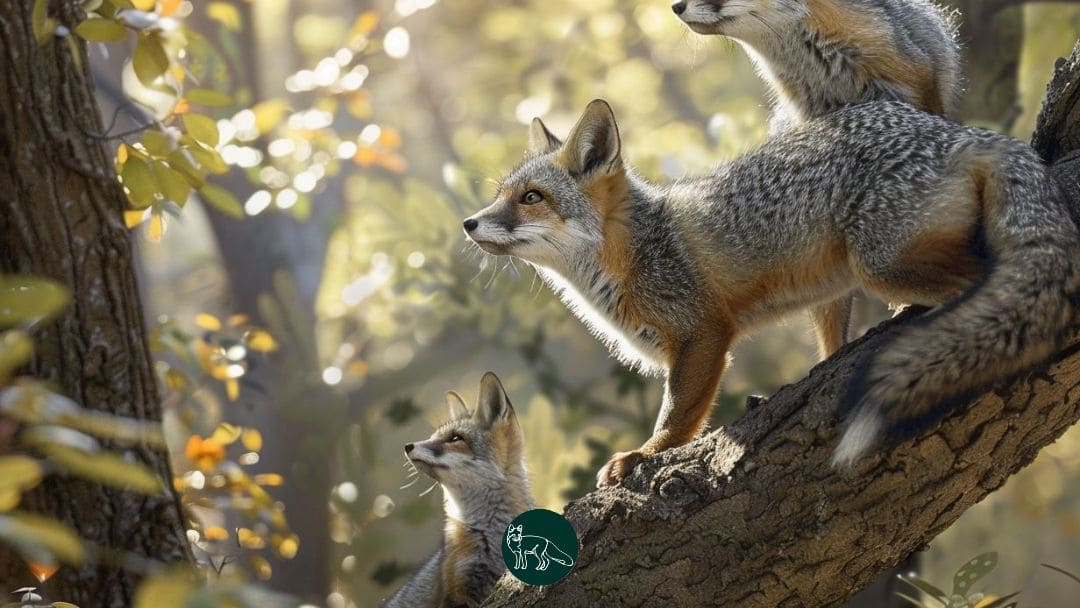Gray Foxes Spotted In Austin: Recently, gray foxes have been making headlines as they have been spotted in urban neighborhoods of Austin, Texas, showcasing their unique traits as skilled rodent hunters and agile climbers.
Short Summary of Adorable Gray Foxes Spotted In Austin:
- Gray foxes are common in Austin and can thrive in urban environments.
- Their remarkable climbing ability sets them apart from other canines.
- They play a crucial ecological role by controlling rodent populations.
The gray fox, known scientifically as Urocyon cinereoargenteus, is one of North America’s most adaptable wildlife species.
Unlike its more well-known relatives, the red fox, the gray fox is equally at home in forests, fields, and urban areas, making this delightful creature a common sight throughout Texas, including in city backyards.
Recently, a Reddit user from Austin, under the handle Opposite-War-7325, shared a charming encounter with a family of gray foxes frolicking in their backyard. “They were out for a day, frolicking in the sun, I was lucky to see them and have my camera handy,” they noted in their post.
“Have not seen them since, only the mom strolls through some nights.” This observation reflects a growing trend of urban sightings of these foxes, prompting local biologists to discuss their behavior and habitat preferences.
Understanding Gray Foxes
Gray foxes are identifiable by their mix of gray and reddish fur, with a black-tipped bushy tail that enhances their distinct looks. Weighing between 6 to 15 pounds and measuring about 40 inches in length, including their tails, they are slightly smaller than their red cousins.
Their unique appearance and smaller size make them agile in their movements, particularly when climbing.
The Climbing Expert of the Canine Family
What truly sets gray foxes apart from other canines, including coyotes and domestic dogs, is their unique climbing ability. Gray foxes are known to ascend trees with exceptional skill, often climbing as high as 30 feet to find food or seek shelter from predators.
This remarkable ability stems from their curved claws, which allow them to grip the rough surfaces of tree bark.
“Gray foxes not only climb trees but do so with remarkable agility, moving about readily among branches,” explains Natasia Moore, an urban biologist with the Texas Parks and Wildlife Department. “This ability helps them escape predators and find food.”
During the nesting season, gray foxes will utilize their climbing skills to forage for bird eggs and small fruits. Their favored meals include not only rodents but also fruits like apples and berries, promoting a diverse diet.
In urban settings where food sources may be scarce or plentiful, they find new ways to adapt.
Urban Backyards: Home Sweet Home
As human populations expand, gray foxes have increasingly settled into urban and suburban environments. According to Moore, “They’re generalist species. They can live in a variety of habitats, and that’s why we spot them even in busy cities like Austin.”
Their adaptability makes them comfortable in areas populated with humans, scavenging for food and making homes under decks, in gardens, and sometimes even in hollow trees.
This means that for residents of Austin, spotting a gray fox in your backyard is far from unusual. As one Reddit user aptly pointed out, the presence of these mammals might also hint at a reduction in rodent populations, as they thrive on small mammals and insects.
Benefits of Coexisting with Gray Foxes
The presence of gray foxes in urban neighborhoods brings significant ecological benefits. They are natural pest controllers, helping keep rodent populations in check.
As Moore stated, “If you have foxes in your backyard, it means you’re not going to have a rodent problem.” Their opportunistic feeding habits minimize the need for chemical pest controls, making them allies for many homeowners.
Notably, their diet consists of fruits, vegetables, insects, and small vertebrates. This balance allows them to thrive in diverse environments while contributing positively to the ecosystems they inhabit.
Ensuring Safety for All
The interaction between humans, pets, and gray foxes raises questions about safety. Generally, these foxes prefer to avoid humans and their pets.
“Gray foxes will most likely run away from us because they’re not very big, and we’re big and scary,” Moore explains. Such behavior illustrates their inherent wariness of human presence.
However, caution is advised, especially for owners of small pets. “For people who have tiny dogs or outdoor pets, we just want to ensure that they are supervised,” Moore added. Keeping pets safe from wildlife interactions is crucial for both parties’ well-being.
Protecting Urban Wildlife
With many gray foxes now making a home in urban settings, residents are encouraged to take measures to coexist peacefully with these creatures.
This includes securing trash bins to avoid attracting them and keeping pet food indoors to discourage unwanted visits.
Moore emphasizes the importance of not unintentionally feeding wildlife, stating, “We want to do things that can help keep our wildlife wild.”
As Austin continues to develop, understanding and respecting the habitats of urban wildlife like gray foxes can ensure a harmonious coexistence.
Their presence is not just charming; it enriches the urban landscape and signifies a healthy, functioning ecosystem.
Conclusion
Gray foxes in urban areas like Austin demonstrate nature’s resilience and adaptability. Their tree-climbing skills, unique dietary habits, and the ecological balance they help maintain present a narrative of wildlife thriving alongside urbanization.
With the right knowledge and respect for their habitats, humans can share their environments with these clever and adorable creatures while fostering a strong rapport with the natural world.
For more insights, visit the Humane Society resource on managing urban wildlife.


